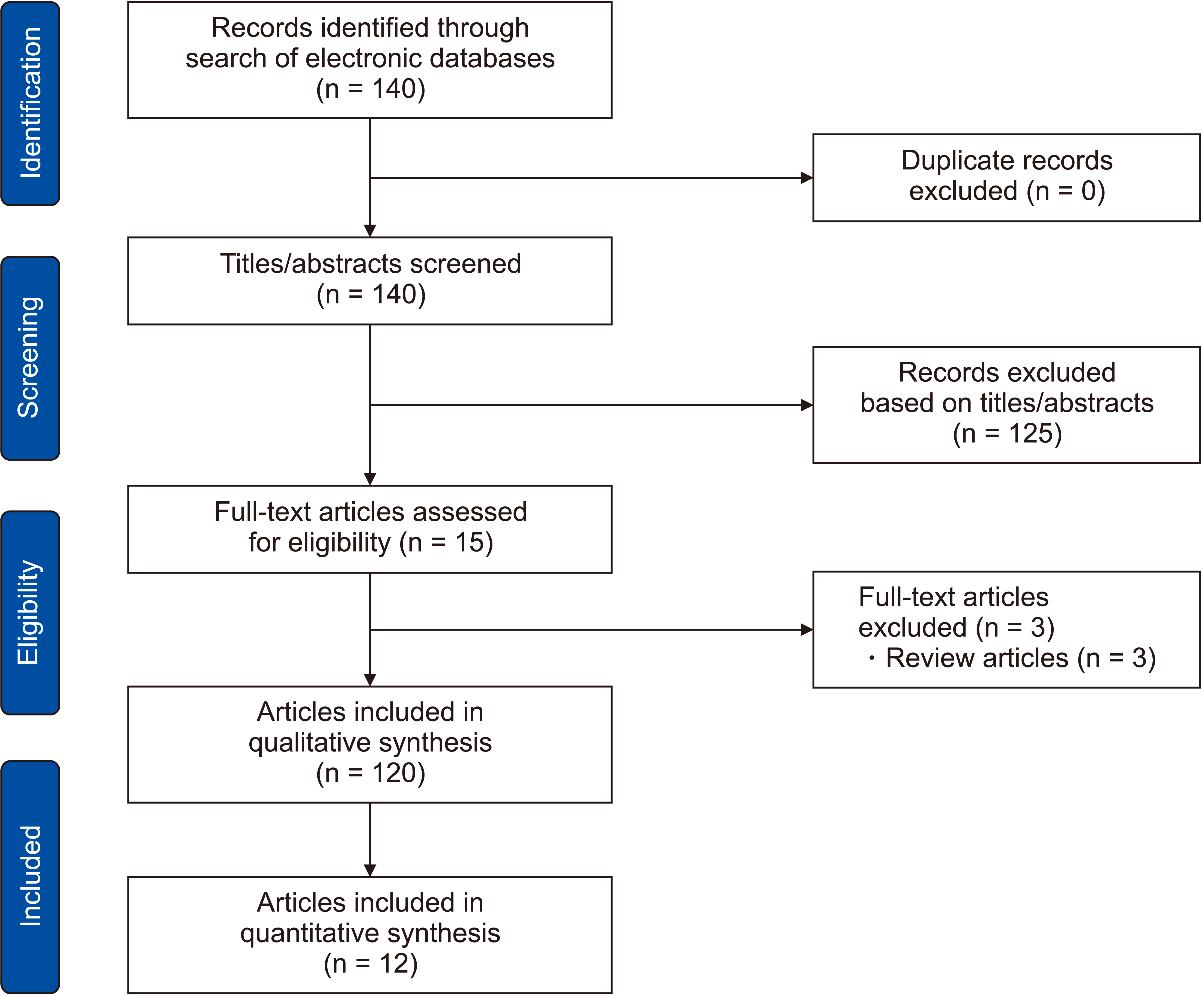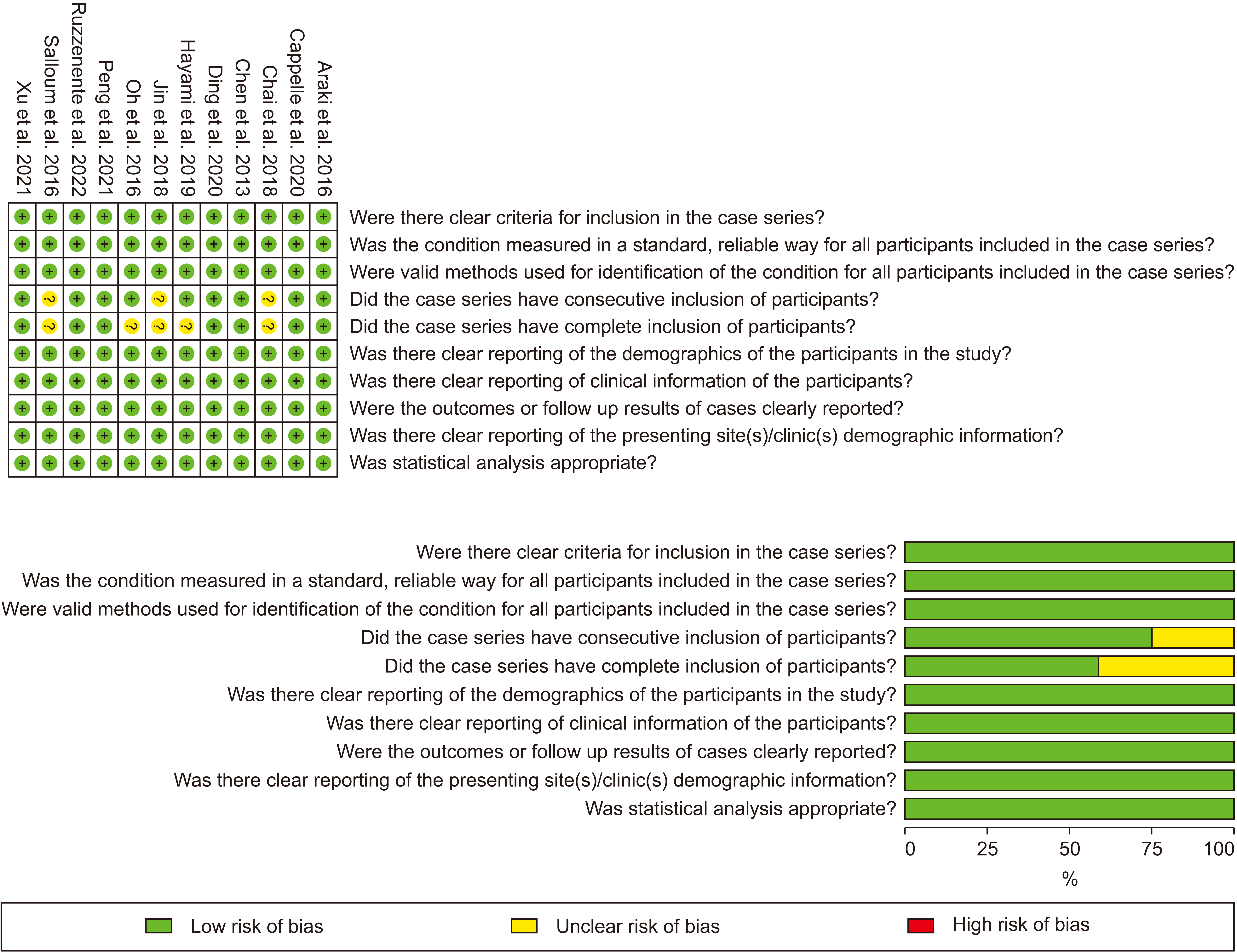1. Wang ZY, Chen QL, Sun LL, He SP, Luo XF, Huang LS, et al. 2019; Laparoscopic versus open major liver resection for hepatocellular carcinoma: systematic review and meta-analysis of comparative cohort studies. BMC Cancer. 19:1047. DOI:
10.1186/s12885-019-6240-x. PMID:
31694596. PMCID:
PMC6833163.

2. Zhang XL, Liu RF, Zhang D, Zhang YS, Wang T. 2017; Laparoscopic versus open liver resection for colorectal liver metastases: a systematic review and meta-analysis of studies with propensity score-based analysis. Int J Surg. 44:191–203. DOI:
10.1016/j.ijsu.2017.05.073. PMID:
28583897.

3. Hajibandeh S, Hajibandeh S, Dave M, Tarazi M, Satyadas T. 2020; Laparoscopic versus open liver resection for tumors in the posterosuperior segments: a systematic review and meta-analysis. Surg Laparosc Endosc Percutan Tech. 30:93–105. DOI:
10.1097/SLE.0000000000000746. PMID:
31929396.

4. Kazaryan AM, Røsok BI, Marangos IP, Rosseland AR, Edwin B. 2011; Comparative evaluation of laparoscopic liver resection for posterosuperior and anterolateral segments. Surg Endosc. 25:3881–3889. DOI:
10.1007/s00464-011-1815-x. PMID:
21735326. PMCID:
PMC3213339.

5. Koh YX, Lee SY, Chiow AKH, Kam JH, Goh BKP, Chan CY. 2017; Laparoscopic caudate lobe resection: navigating the technical challenge. Ann Laparosc Endosc Surg. 2:39. DOI:
10.21037/ales.2017.03.04.

6. Oh D, Kwon CH, Na BG, Lee KW, Cho WT, Lee SH, et al. 2016; Surgical techniques for totally laparoscopic caudate lobectomy. J Laparoendosc Adv Surg Tech A. 26:689–692. DOI:
10.1089/lap.2016.0161. PMID:
27599012.

7. Liberati A, Altman DG, Tetzlaff J, Mulrow C, Gøtzsche PC, Ioannidis JP, et al. 2009; The PRISMA statement for reporting systematic reviews and meta-analyses of studies that evaluate healthcare interventions: explanation and elaboration. BMJ. 339:b2700. DOI:
10.1136/bmj.b2700. PMID:
19622552. PMCID:
PMC2714672.

9. Petrie A, Bulman JS, Osborn JF. 2003; Further statistics in dentistry Part 8: systematic reviews and meta-analyses. Br Dent J. 194:73–78. DOI:
10.1038/sj.bdj.4809877. PMID:
12577072.

10. Chen KH, Jeng KS, Huang SH, Chu SH. 2013; Laparoscopic caudate hepatectomy for cancer--an innovative approach to the no-man's land. J Gastrointest Surg. 17:522–526. DOI:
10.1007/s11605-012-2115-z. PMID:
23297026.

11. Salloum C, Lahat E, Lim C, Doussot A, Osseis M, Compagnon P, et al. 2016; Laparoscopic isolated resection of caudate lobe (Segment 1): a safe and versatile technique. J Am Coll Surg. 222:e61–e66. DOI:
10.1016/j.jamcollsurg.2016.01.047. PMID:
27113524.

12. Araki K, Fuks D, Nomi T, Ogiso S, Lozano RR, Kuwano H, et al. 2016; Feasibility of laparoscopic liver resection for caudate lobe: technical strategy and comparative analysis with anteroinferior and posterosuperior segments. Surg Endosc. 30:4300–4306. DOI:
10.1007/s00464-016-4747-7. PMID:
26823056.

13. Chai S, Zhao J, Zhang Y, Xiang S, Zhang W. 2018; Arantius ligament suspension: a novel technique for retraction of the left lateral lobe liver during laparoscopic isolated caudate lobectomy. J Laparoendosc Adv Surg Tech A. 28:740–744. DOI:
10.1089/lap.2017.0572. PMID:
29232529.

14. Jin B, Jiang Z, Hu S, Du G, Shi B, Kong D, et al. 2018; Surgical technique and clinical analysis of twelve cases of isolated laparoscopic resection of the hepatic caudate lobe. Biomed Res Int. 2018:5848309. DOI:
10.1155/2018/5848309. PMID:
29568758. PMCID:
PMC5820552.

15. Hayami S, Ueno M, Kawai M, Miyamoto A, Suzaki N, Hirono S, et al. 2019; Standardization of surgical procedures for laparoscopic Spiegel lobectomy: a single-institutional experience. Asian J Endosc Surg. 12:232–236. DOI:
10.1111/ases.12609. PMID:
30549230.

16. Cappelle M, Aghayan DL, van der Poel MJ, Besselink MG, Sergeant G, Edwin B, et al. 2020; A multicenter cohort analysis of laparoscopic hepatic caudate lobe resection. Langenbecks Arch Surg. 405:181–189. DOI:
10.1007/s00423-020-01867-2. PMID:
32239290.

17. Ding Z, Huang Y, Liu L, Xu B, Xiong H, Luo D, et al. 2020; Comparative analysis of the safety and feasibility of laparoscopic versus open caudate lobe resection. Langenbecks Arch Surg. 405:737–744. DOI:
10.1007/s00423-020-01928-6. PMID:
32648035.

18. Xu G, Tong J, Ji J, Wang H, Wu X, Jin B, et al. 2021; Laparoscopic caudate lobectomy: a multicenter, propensity score-matched report of safety, feasibility, and early outcomes. Surg Endosc. 35:1138–1147. DOI:
10.1007/s00464-020-07478-8. PMID:
32130488.

19. Peng Y, Liu F, Xu H, Guo S, Wei Y, Li B. 2021; Propensity score matching analysis for outcomes of laparoscopic versus open caudate lobectomy. ANZ J Surg. 91:E168–E173. DOI:
10.1111/ans.16512.

20. Ruzzenente A, Ciangherotti A, Aldrighetti L, Ettorre GM, De Carlis L, Ferrero A, et al. 2022; Technical feasibility and short-term outcomes of laparoscopic isolated caudate lobe resection: an IgoMILS (Italian Group of Minimally Invasive Liver Surgery) registry-based study. Surg Endosc. 36:1490–1499. DOI:
10.1007/s00464-021-08434-w. PMID:
33788031. PMCID:
PMC8758628.

21. Ding Z, Liu L, Xu B, Huang Y, Xiong H, Luo D, et al. 2021; Safety and feasibility for laparoscopic versus open caudate lobe resection: a meta-analysis. Langenbecks Arch Surg. 406:1307–1316. DOI:
10.1007/s00423-020-02055-y. PMID:
33404881.






 PDF
PDF Citation
Citation Print
Print





 XML Download
XML Download